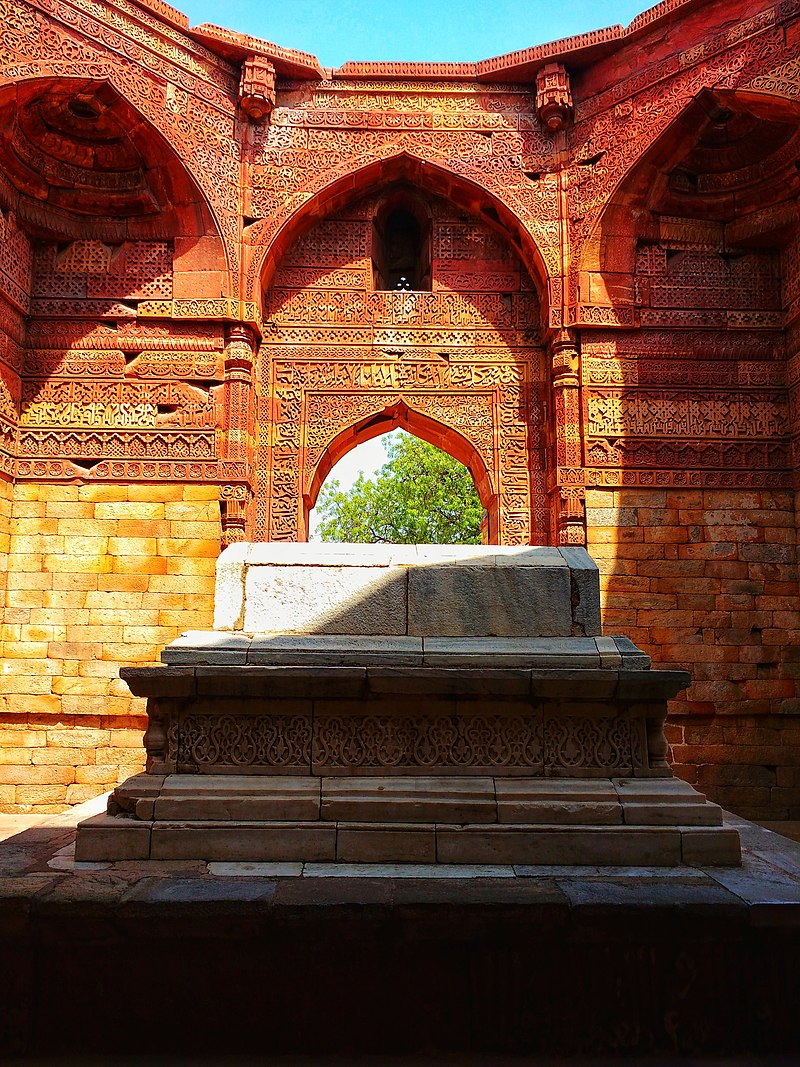Iltutmish – First Ilbari ruler (1211-1236 AD)
Iltutmish was the greatest of the sultans of the Das dynasty. Shamsuddin Iltutmish was the real founder of the Delhi Sultanate. He was a slave who could rise to such a high position on the strength of his ability. He was originally from the Ilbari caste of Turkistan. He belonged to a high family. His brothers were jealous of Iltutmish’s talent, so they tried to deprive him of his ancestral residence and protection. It was sold to a merchant from Bukhara, from which another person bought and sold to Qutbuddin Aibak. With the strength of his ability, Iltutmish gradually increased his status.
 |
| Illtumish Tomb in Qutub Minar Complex-PHPTO CREDIT WIKIPEDIA |
Recognizing his talent, Qutubuddin appointed him the Subedar of Badaun.
Qutbuddin Aibak married his daughter to Iltutmish.
- In return for his services, Iltutmish got freedom from slavery by order of Muhammad Ghori and also got the title of Amir-ul-Umra.
- After the death of Qutubuddin Aibak, an incompetent person named Aram Shah was placed on the throne.
- But due to the incompetence of Aram Shah, the chieftains invited Iltutmish to the throne and Iltutmish took the throne of Delhi without delay.
- The Caliph of Baghdad recognized Iltutmish and presented him with a cloak of honor.
- The Caliph conferred the title of Sultan-e-Azam (Great Ruler) to Iltutmish.
- Iltutmish depicted himself as the messenger of the Caliph on his coins.
After becoming the ruler, Iltutmish had to face two of his toughest rivals. One is Tajuddin Yaldoz and the other is Uch and Multan’s provincial president Nasruddin Qubacha.
Tajuddin Yaldoz – Tajuddin Yaldoz considered himself the successor of Mohammad Ghori, and he could not bear that the Islamic State in India should become independent. In 1214 AD, Yalduz took control of Lahore. This was a very unbearable situation for Iltutmish. Iltutmish rose against Yalduj and defeated him in the battle of Tarain near Thaneswar. Yaldoz was taken captive and imprisoned in a fort in Badaun where he was later murdered. In this way Iltutmish eliminated one of the biggest enemies from his path.
Nasiruddin Qubacha- Iltutmish was also successful in suppressing Nasiruddin Qubacha, the provincial president of Uch and Multan.
After the death of Qutubuddin, the Qubacha occupied a part of Punjab.
In 1227 AD, Iltutmish expelled the Uddand Qubacha from the Punjab.
Iltutmish, enraged by the revolt of Qubacha, completely defeated Qubacha in 1227 AD.
In Bengal, Ali Mardan himself had declared Mo independent. Therefore, in 1225 AD Iltutmish himself led the campaign against him and punished Mardan’s successor Ghiyasuddin.
In 1229 AD, the Khilji owners revolted in Bengal, but Iltutmish defeated the rebel ‘Balka’ and made Alauddin Jani the manager of Bengal.
Rajput-
In 1226 AD, Iltutmish besieged Ranthambore, forced Udai Singh to surrender and returned power on the condition of paying taxes.
In 1231 AD, he also surrounded Gwalior and forced Malai Vamardev to surrender there as well.
In 1234-35 AD, Iltutmish, leading an expedition to Malwa, plundered Ujjain and destroyed the temple of Mahakal at Ujjain.
Mongol invasion
During the reign of Iltutmish, in 1221 AD, the Mongols first appeared on the banks of the Indus river under their famous leader Genghis Khan. Genghis was born in 1155 AD and his original name was Timuchin.
Genghis Khan attacked Jalaluddin Mangbarni, the last Shah of Khwajam or Khiva, then he (Jalaluddin Mangbarni) fled to Punjab and sought refuge in the kingdom of Iltutmish, the Sultan of Delhi refused the request of his uninvited guest. Mangbarni joined the Khokhars and defeated Nasiruddin Qubacha of Multan, looted Sindh and North Gujarat and went to Paras. The Mongols also returned. In this way India was saved from a terrible crisis.
Iltutmish’s last campaign was against Banyan.
Iltutmish died on 29 April 1236 AD.
The tomb of Iltutmish is located in Delhi which is roofless.
In 1231-32 AD, Iltutmish completed the construction of the famous Qutub Minar near Mehrauli in Delhi. This is a living proof of the importance of Iltutmish. Qutb Minar is not named after Qutbuddin Aibak, but it is named after Khwaja Qutbuddin, a resident of Uch near Baghdad who came to India for residence.
According to Ibn-Batuta’s opinion, Iltutmish had arranged a bell and chain in his palace so that the victim could reach the Sultan without much difficulty.
Iltutmish made Delhi his capital in place of Lahore.
It was Iltutmish who gave the country (sultanate) a capital, a sovereign state, a monarchical type of government and a ruling or noble class called Turkan-i-Chalgani or Chalisa (group of forty nobles) which was a selector of this period. The ruling class was, provided.
Iltutmish divided the empire into innumerable small iqtas.
The meaning of Iqta is to transfer agricultural land or rent to someone in exchange for a cash salary.
Iltutmish introduced two types of original coins of the Sultanate – the silver tanka and the copper jital.
It was Iltutumish who gave shelter to Minhaj-us-Siraj, the author of Tabaqat-e-Nasiri.
Awafi composed the Jawami-ul-Hikayat during the reign of Iltutmish.